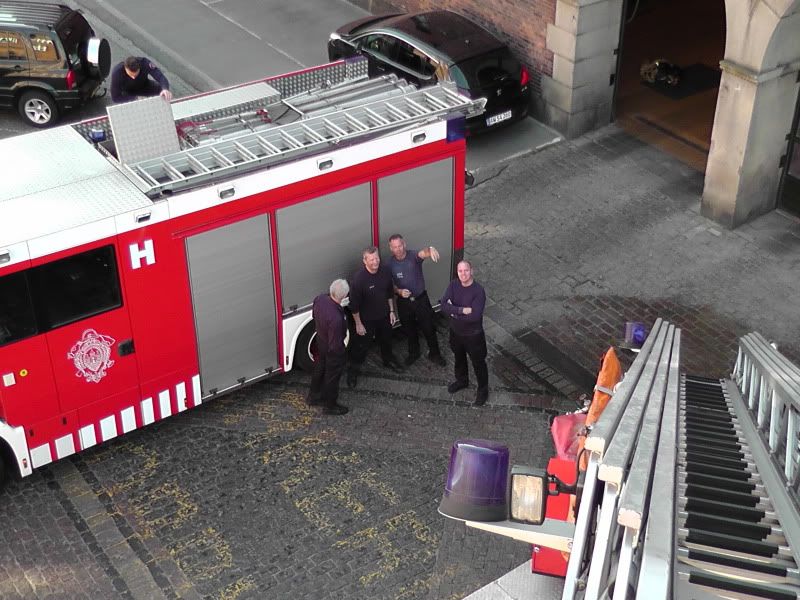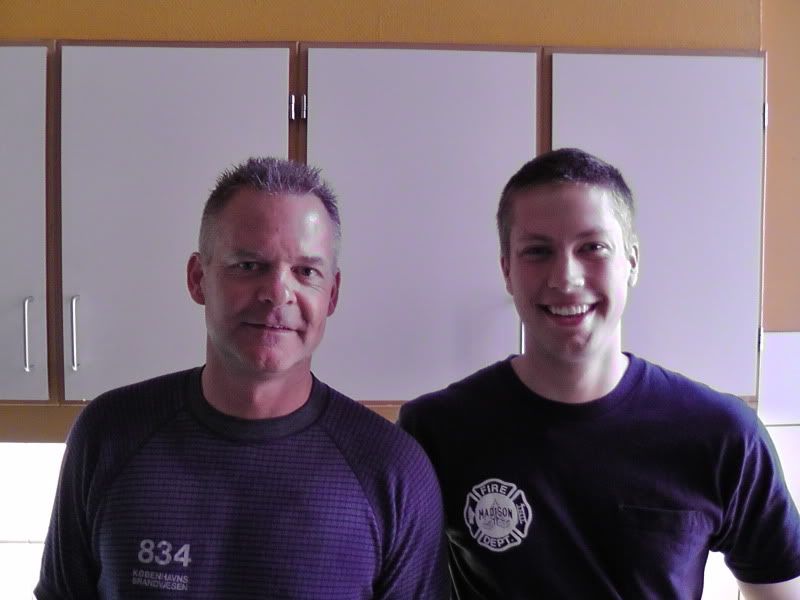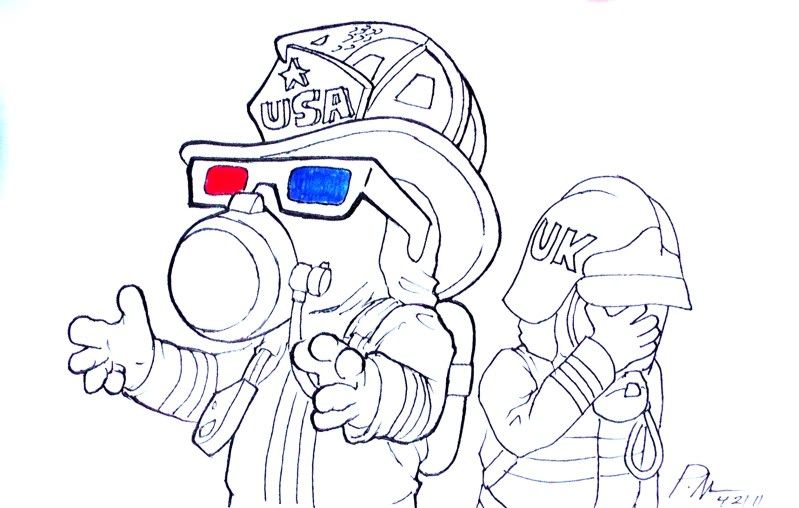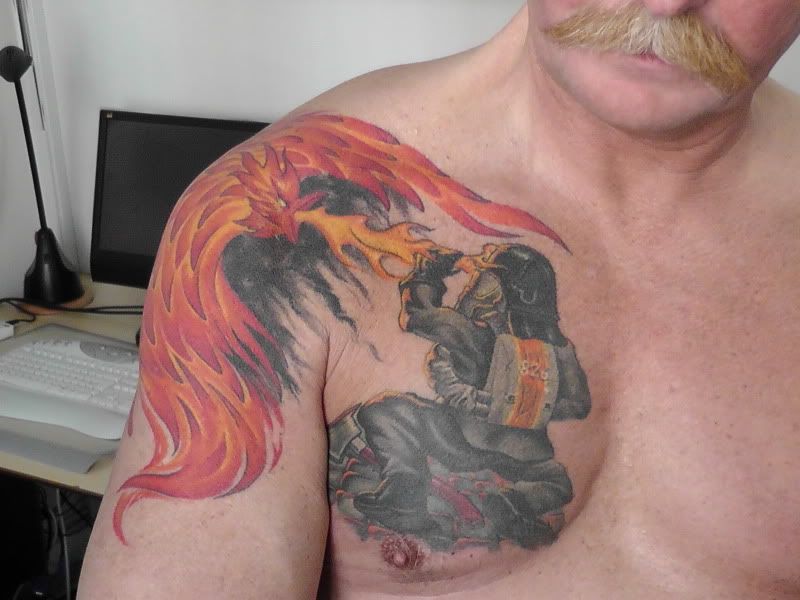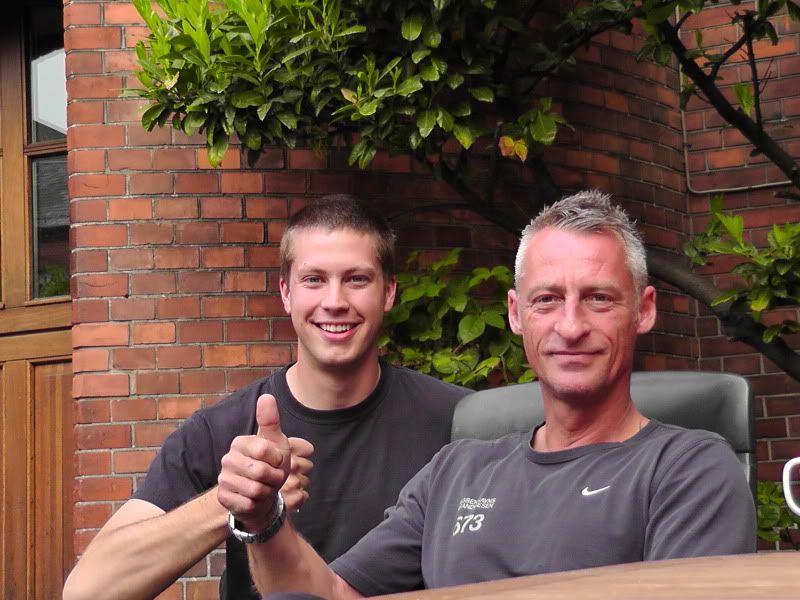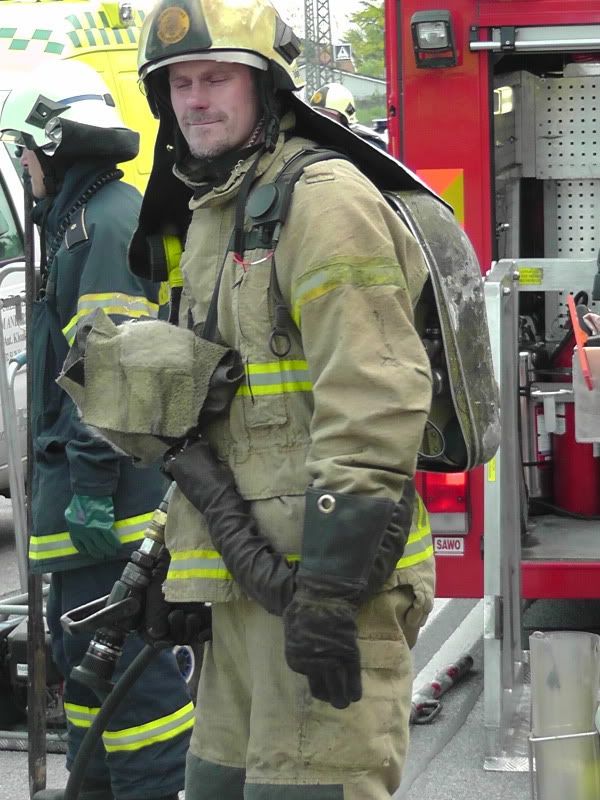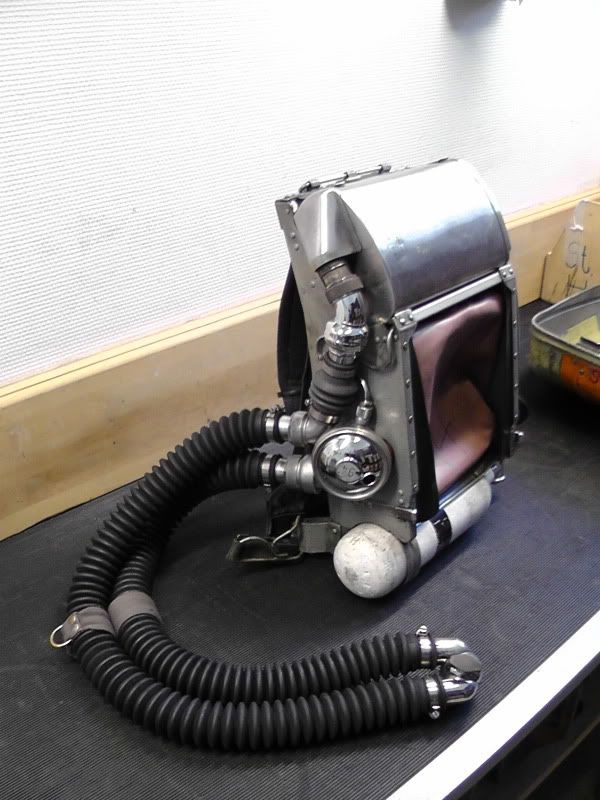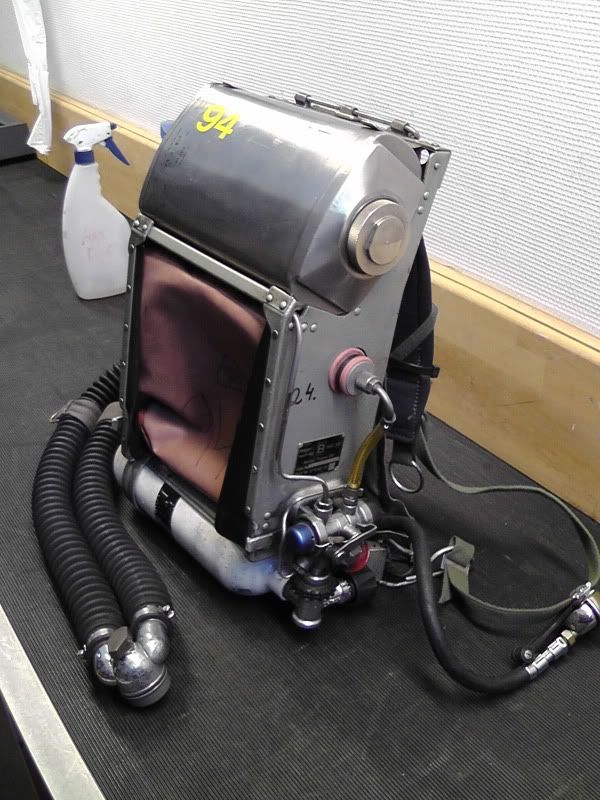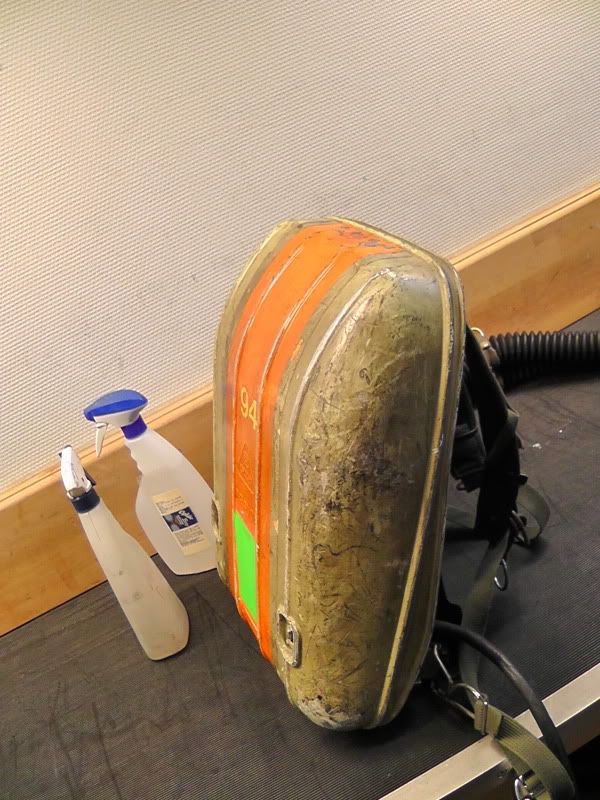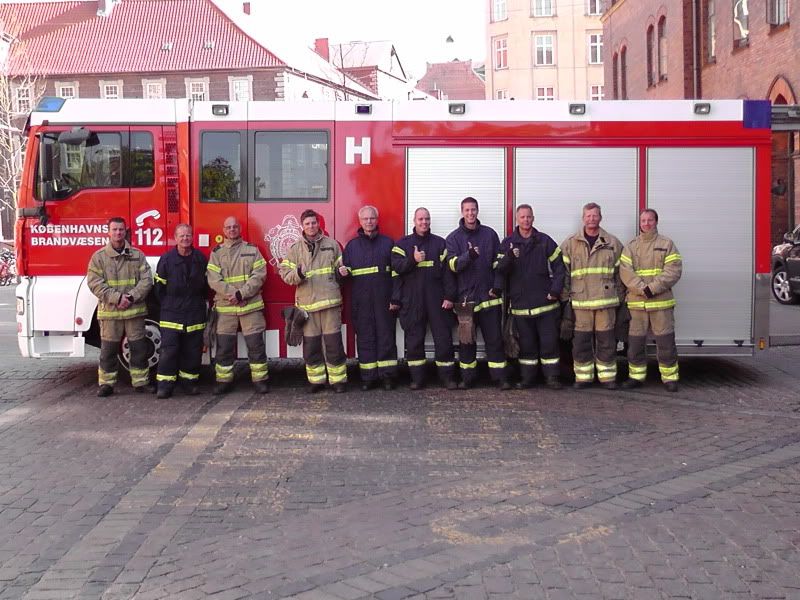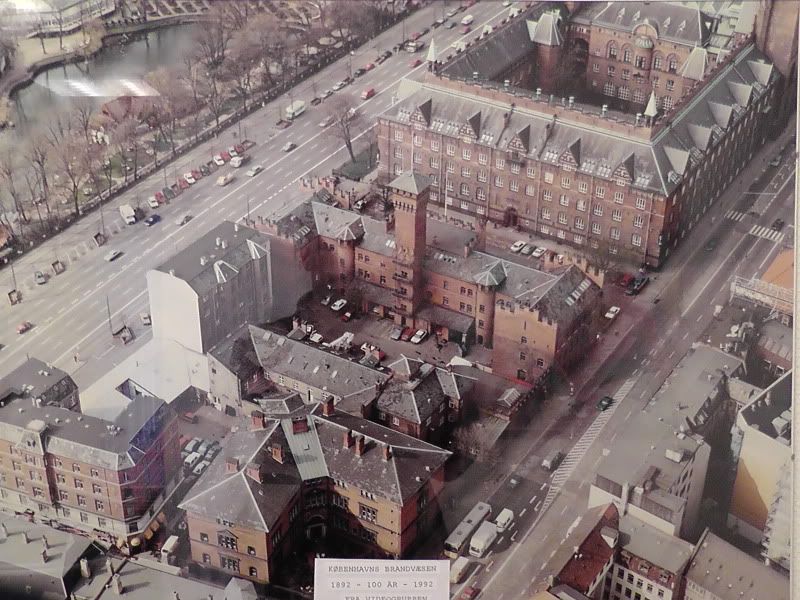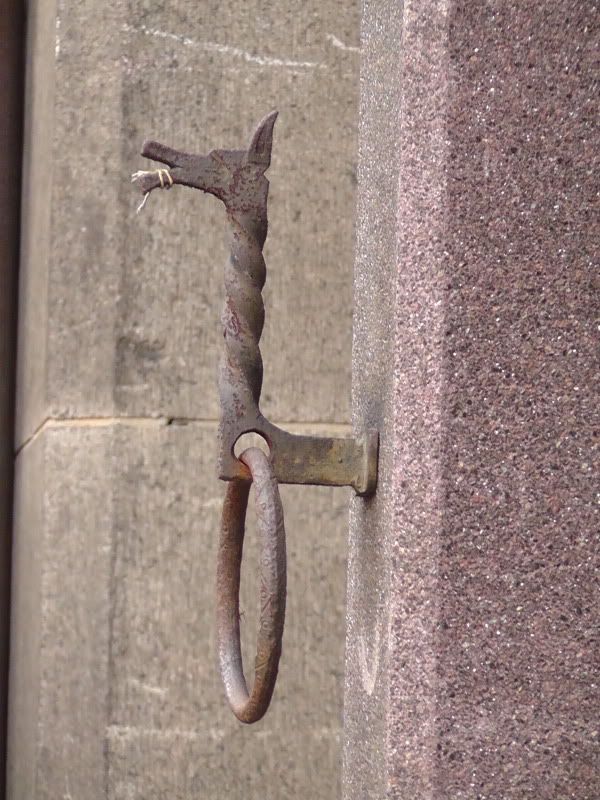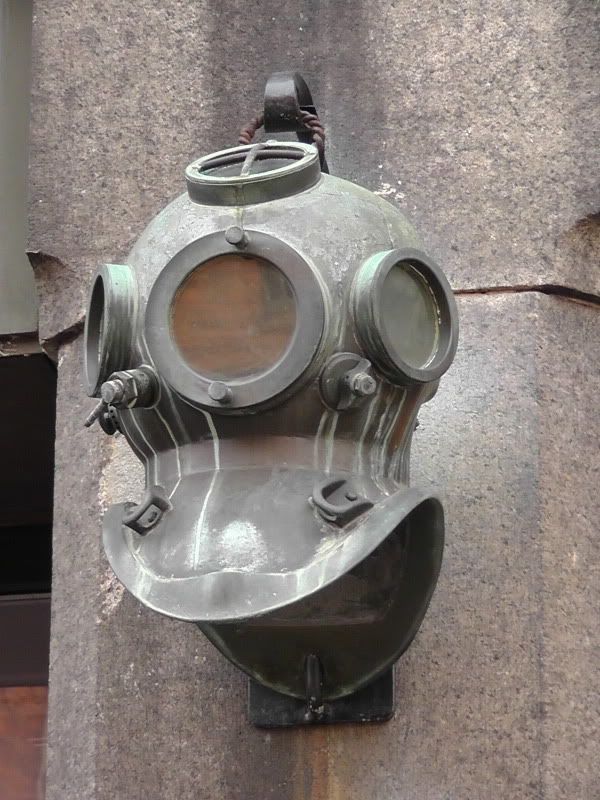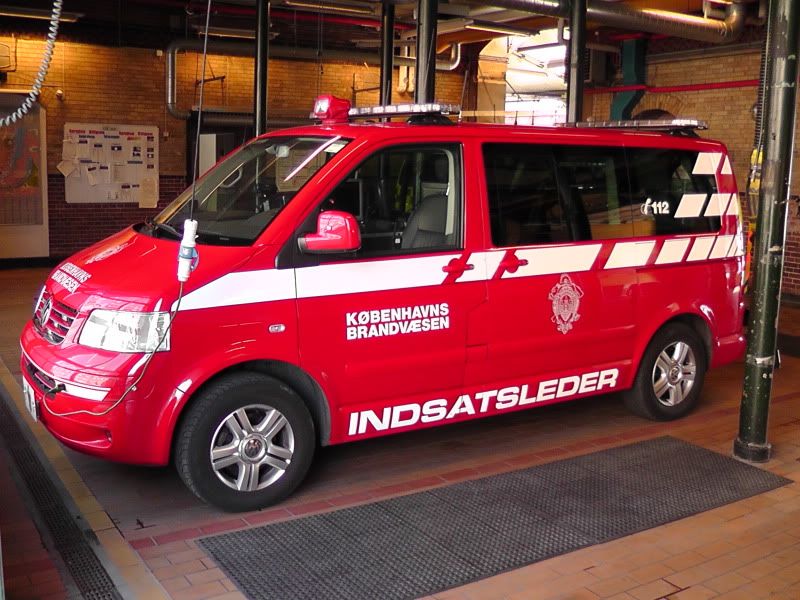Because I find myself having trouble creating enough posts for all these photos, here is the link for all of them:
Copenhagen album
Sunday, August 14, 2011
Sunday, June 26, 2011
Steam? No sweat.
As a ride-along/observer with the CFB I was issued boots, gloves, helmet, and a set of turnout gear. Unlike my regular American turnouts, which are very thick and cumbersome, danish turnout gear was very thin, like a light jacket.
In terms of maneuverability thin is great, but how could this gear possibly protect the wearer from the fires heat? And, given that CFB uses steam conversion as the primary method of fire attack, how do they not get steam burns?
The answer is rather clever. The firefighters regular work uniform is a tight sweat wicking layer (Seen below), when they get a call they put a cotton sweatshirt on over this and then they're turnout coat over that.
Henry wearing the sweat wicking work shirt, yours truly smiling like a dope
Size isn't everything
In the USA more and more firefighters are pushing for larger diameter hoses. Reducing friction loss is one way to get more water on fires which are getting hotter and more dynamic with every new building that goes up. Bigger fire = Bigger water =Bigger hose.
American firefighters wrestle with a 2.5" hose
But in Copenhagen it's a different story.
What's that coming off the engine? An extension cord? Some sort of tow cable? Nope, that's the CFB's attack line which they use on 90% of fires. It resembles America's booster lines, only smaller.... just slightly thicker then a garden hose. Obviously it's very easy to advance into a building and maneuver once the fire is found. However, I couldn't fathom actually crawling into a smoke filled building hoping extinguish a serious fire with such a dinky hose.
I asked how they could get away with so little water, and I received a completely new perspective on water and it's place in the fire service.
First off, let me dispel any myths about European firefighters being tentative about fire attack. In Copenhagen's case, nothing could be further from the truth. They like to take their tiny hoses and get as close to the fire as they can possibly stand before opening up the fire stream at all. Is "undercompensation" a word? Then, where I've been trained to never use a fog stream when in an active fire environment for fear of steam burns, they just hold onto they're helmets and let steam conversion kick all the butts present. Their's and the fire's.
In Europe, research in fire science has created a new system of fire attack, many people refer to it as three dimensional firefighting. These strategies and tactics are slowly trickling into the states, but transferring European tactics to American fires is kind of a rough process.
The magical world of 3D firefighting (illustration by yours truly)
I am by no means an expert on three dimensional firefighting so I won't try to explain it like I am. Suffice it to say that water expands 1700 times when it converts to steam. In 3D firefighting this principle is employed by directing a small amount of water into the hottest part of a fire and letting it convert to steam snuffing the fire out. There's way more to it then that but you get the idea.
One advantage of using so little water is the reduction in water damage. CFB firefighters take pride when there isn't a puddle on the floor or a drop of water dripping from the ceiling after a fire. Water can do just as much damage as fire (especially in Copenhagen's ancient wood and stone apartment buildings which butt up against each other from one side of the city to the other) so reducing water damage is very important to the CFB.
Typical construction in downtown Copenhagen
I was allowed into some of the apartments after the fire had been extinguished, and I will admit that there was no water anywhere to be seen.
See? Dry as a bone.
It is important to note that the fire load (How big the fire will be, based on the amount of fuel) in a Copenhagen apartment is very different then what you would find in a comparable apartment in America. In the states everything we have is made of plastics, and we just own a ton of stuff. Plastic burns very hot, very fast and generate nasty volatile smoke. Not only is a fire in Copenhagen likely to be cooler, it will probably be less dynamic as well (i.e. conditions will change slower and more predictably).
The Copenhagen Fireman's Union is currently fighting the introduction of foam insulation into the building code, I just wonder how many firefighters realized the dangers plastics, Styrofoams, and other synthetics when they were first being used in the USA.
To really hammer home just how little water they use I'll discuss their hydrants and the CFB's ability to use them.
CFB fire hydrant
1 discharge, about 3" diameter off a hydrant; about 4" in diameter. The nut at the bottom can be removed to pump the left over water from the hydrant after use. Basically this was a much smaller hydrant then I was expecting to see in a city as big as Copenhagen.
Lastly, here in the states fire engine are equipped to attach their LDH (large diameter hose) to the hydrant and then drive to the fire, the hose deploying off the back of the rig as it rolls down the road. In Copenhagen they cannot do this. If a connection to a Hydrant must be made, someone must take hose from the engine to the nearest hydrant. Good thing they have handy dandy hose/hydrant carts they can just wheel over there.
Its just funny to think that they're usually flowing about 70 LPM (liters per minute) (18 GPM) and our smallest attack line on the MFD flows 684 LPM (180 GPM)
American firefighters wrestle with a 2.5" hose
But in Copenhagen it's a different story.
What's that coming off the engine? An extension cord? Some sort of tow cable? Nope, that's the CFB's attack line which they use on 90% of fires. It resembles America's booster lines, only smaller.... just slightly thicker then a garden hose. Obviously it's very easy to advance into a building and maneuver once the fire is found. However, I couldn't fathom actually crawling into a smoke filled building hoping extinguish a serious fire with such a dinky hose.
I asked how they could get away with so little water, and I received a completely new perspective on water and it's place in the fire service.
First off, let me dispel any myths about European firefighters being tentative about fire attack. In Copenhagen's case, nothing could be further from the truth. They like to take their tiny hoses and get as close to the fire as they can possibly stand before opening up the fire stream at all. Is "undercompensation" a word? Then, where I've been trained to never use a fog stream when in an active fire environment for fear of steam burns, they just hold onto they're helmets and let steam conversion kick all the butts present. Their's and the fire's.
In Europe, research in fire science has created a new system of fire attack, many people refer to it as three dimensional firefighting. These strategies and tactics are slowly trickling into the states, but transferring European tactics to American fires is kind of a rough process.
The magical world of 3D firefighting (illustration by yours truly)
I am by no means an expert on three dimensional firefighting so I won't try to explain it like I am. Suffice it to say that water expands 1700 times when it converts to steam. In 3D firefighting this principle is employed by directing a small amount of water into the hottest part of a fire and letting it convert to steam snuffing the fire out. There's way more to it then that but you get the idea.
One advantage of using so little water is the reduction in water damage. CFB firefighters take pride when there isn't a puddle on the floor or a drop of water dripping from the ceiling after a fire. Water can do just as much damage as fire (especially in Copenhagen's ancient wood and stone apartment buildings which butt up against each other from one side of the city to the other) so reducing water damage is very important to the CFB.
Typical construction in downtown Copenhagen
I was allowed into some of the apartments after the fire had been extinguished, and I will admit that there was no water anywhere to be seen.
See? Dry as a bone.
It is important to note that the fire load (How big the fire will be, based on the amount of fuel) in a Copenhagen apartment is very different then what you would find in a comparable apartment in America. In the states everything we have is made of plastics, and we just own a ton of stuff. Plastic burns very hot, very fast and generate nasty volatile smoke. Not only is a fire in Copenhagen likely to be cooler, it will probably be less dynamic as well (i.e. conditions will change slower and more predictably).
The Copenhagen Fireman's Union is currently fighting the introduction of foam insulation into the building code, I just wonder how many firefighters realized the dangers plastics, Styrofoams, and other synthetics when they were first being used in the USA.
To really hammer home just how little water they use I'll discuss their hydrants and the CFB's ability to use them.
CFB fire hydrant
1 discharge, about 3" diameter off a hydrant; about 4" in diameter. The nut at the bottom can be removed to pump the left over water from the hydrant after use. Basically this was a much smaller hydrant then I was expecting to see in a city as big as Copenhagen.
Lastly, here in the states fire engine are equipped to attach their LDH (large diameter hose) to the hydrant and then drive to the fire, the hose deploying off the back of the rig as it rolls down the road. In Copenhagen they cannot do this. If a connection to a Hydrant must be made, someone must take hose from the engine to the nearest hydrant. Good thing they have handy dandy hose/hydrant carts they can just wheel over there.
Its just funny to think that they're usually flowing about 70 LPM (liters per minute) (18 GPM) and our smallest attack line on the MFD flows 684 LPM (180 GPM)
EMS dispatch
Copenhagen has recently switched to a dispatch system where a 911 call taker determines it's a medical call and transfers it to a nurse, who dispatches ambulances accordingly. Two types of ambulances are available: one with two paramedics, and the other with an emergency doctor and paramedic driver. Emergency doctors can bring much of the hospital to the patient, being able to make diagnosis's and write prescriptions, saves many trips to the hospital for EMTs and patients alike.
The only complaint about the new dispatch system I heard was, while the nurses doing the dispatching were much more medically knowledgeable than the previous dispatchers, they were not the strongest dispatches in terms of sending the appropriate units to the right place.
The only complaint about the new dispatch system I heard was, while the nurses doing the dispatching were much more medically knowledgeable than the previous dispatchers, they were not the strongest dispatches in terms of sending the appropriate units to the right place.
Saturday, June 4, 2011
Fit old firefighters
This is me and Lars, I'm 22 Lars is 55. When I met Lars I noticed that he was very friendly, happy to answer questions and help me find my way through the shift. All in all, he struck me as a pretty normal 55 year-old. Lars is a firefighter's firefighter, riding backwards on the was to calls, pulling lines, diving into smoke all with a grin from ear to ear.
Now 50-something year-old firefighters are nothing new to me, I've met many firefighters who are much older. But Lars and his brother firefighters had a surprise for me.
I was in the office with the Chief in Charge and Lars, and the Chief said "I don't like tattoos, but Lars has the best tattoo I've ever seen. You should see it" On command Lars whipped off his shirt and.... well, look at the picture.
Awesome tattoo? Yes, no question.
But what really surprised me was the fact that the tattoo was on what could have been a very fit 30 yearold's body.
The average age of the firefighters I worked with in Copenhagen was about 48, near as I can figure, and Lars' level of physical fitness seemed to be the standard, with out-of-shape firefighters being greatly in the minority.
Lars and his crew invited me to "train" (work out) with them, at the time I didn't realize that Copenhagen firefighters are required to work out for 2 hours each shift, or that I was in for a real butt kicking. We did a CrossFit workout: 10 Push-ups, box jumps, burpies, sit-ups with leg lift/weight, and shoulder presses. then 9 of each, 8 of each etc. No rest, no water, just peddle to the mettle until your done. I was able to hold my own and not be left in the dust, but considering the other firefighters were 30 years my senior, I don't feel entitled to boast. The crews worked out together, shouting and laughing together the whole time.
After the CrossFit routine, we took a water break and got a call for a fire alarm, turned out to be nothing, but it got me my trip to the famous Tivoli Gardens.
When we got back to the station I was in desperate need of a shower. But these Danes, not to be distracted by a ride in a fire engine went right back to they're workout! Treadmills and Stationary bikes to round out they're required workouts.
I was sore for the next 2 days...
We have 50 year-old firefighters in the states all over the place, but usually they fill the role of driver, Lt., or Captain. It was very inspiring to see these guys in action.
Funny thing is the firefighters I talked to are proud of they're strength and stamina, but don't claim to be particularly healthy. They smoke like chimneys, and when they're off shift they're no strangers to certain beverages either. I guess this reflects on the general health of Denmark as a country.
Me and Jimmi, two thumbs up! (although his thumb is in front of mine)
Now 50-something year-old firefighters are nothing new to me, I've met many firefighters who are much older. But Lars and his brother firefighters had a surprise for me.
I was in the office with the Chief in Charge and Lars, and the Chief said "I don't like tattoos, but Lars has the best tattoo I've ever seen. You should see it" On command Lars whipped off his shirt and.... well, look at the picture.
Awesome tattoo? Yes, no question.
But what really surprised me was the fact that the tattoo was on what could have been a very fit 30 yearold's body.
The average age of the firefighters I worked with in Copenhagen was about 48, near as I can figure, and Lars' level of physical fitness seemed to be the standard, with out-of-shape firefighters being greatly in the minority.
Lars and his crew invited me to "train" (work out) with them, at the time I didn't realize that Copenhagen firefighters are required to work out for 2 hours each shift, or that I was in for a real butt kicking. We did a CrossFit workout: 10 Push-ups, box jumps, burpies, sit-ups with leg lift/weight, and shoulder presses. then 9 of each, 8 of each etc. No rest, no water, just peddle to the mettle until your done. I was able to hold my own and not be left in the dust, but considering the other firefighters were 30 years my senior, I don't feel entitled to boast. The crews worked out together, shouting and laughing together the whole time.
After the CrossFit routine, we took a water break and got a call for a fire alarm, turned out to be nothing, but it got me my trip to the famous Tivoli Gardens.
When we got back to the station I was in desperate need of a shower. But these Danes, not to be distracted by a ride in a fire engine went right back to they're workout! Treadmills and Stationary bikes to round out they're required workouts.
I was sore for the next 2 days...
We have 50 year-old firefighters in the states all over the place, but usually they fill the role of driver, Lt., or Captain. It was very inspiring to see these guys in action.
Funny thing is the firefighters I talked to are proud of they're strength and stamina, but don't claim to be particularly healthy. They smoke like chimneys, and when they're off shift they're no strangers to certain beverages either. I guess this reflects on the general health of Denmark as a country.
Me and Jimmi, two thumbs up! (although his thumb is in front of mine)
Wednesday, May 25, 2011
CFD Smoke Divers SCBA (air pack)
One of the most dramatic differences in equipment/technology I observed in Copenhagen was the Smoke Divers' SCBA.
Normal CFB firefighters used a very standard compressed air, composite cylinder, open-circuit SCBA, without any of the bells and whistles I've grown accustomed to. No PASS alarm, RIT connection, or Heads Up Display (HUD).
The CFB "Smoke Divers" however, use a closed circuit SCBA which was actually designed for mine rescue operations. These packs enable firefighters to operate in an IDLH (Immediate Danger to Life and Health) for two hours! Two hours you say? They must be very heavy and cumbersome right? Nope. They're packs weigh slightly less then my Scott 45 minute SCBA, and are actually smaller in profile.
How does that work you say? Well, I'll tell you.
- 100% oxygen is supplied from a 1 liter cylinder at the bottom of the pack
- O2 fills a rubber lung in the middle of the pack
- O2 is breathed from the rubber lung and exhaled via the black corrugated lines
- Exhaled O2 and CO2 go to the filter at the top of the pack
- CO2 is filtered from the O2 using a dry chemical similar to lime stone
- Remaining O2 returns to the rubber lung to be breathed again
The major problem with the SCBAs is that the filtering system relies on and exothermic chemical reaction (heat generating reaction) to remove the CO2. This means that after the firefighters has been wearing the pack for and hour they're O2 will start being hotter and hotter. This problem is compounded in a fire by the fact that the SCBA attracts and holds the radiant heat from the fire.
Now every safety conscious firefighter is saying that is unsafe to be in a fire for an hour let alone two, what is the point of having a pack that last for so long?
CFB has the Smoke Diving packs to fight tunnel fires, which may require firefighter to travel through a smoke filled environment for quite some time before actually engaging the fire. Smoke Diver's wear these packs for all firefighting operations to stay familiar with they're use.
What I noticed when wearing one, was that since you're breathing from a non-pressurized source (the rubber lung) there isn't any sound with your breathing. This was simultaneously unnerving and really nice, nice because it was easier to hear what was going on outside of my mask, but unnerving because I didn't know if I was breathing without the familiar sound of my regulator giving me another shot of air.
Smoke Divers SCBA with protective cover
Copenhagen Fire Brigade (CFB) 2011
On May 3rd 2011 I traveled to Copenhagen, Denmark, to do three 24-hour ride alongs with different companies of the CFB. With a department history going back to 1687 (324 years) and modern European firefighting equipment/tactics, the CFB is a wonderful mix between tradition and innovation.
H station (yes I took a photo of a photo)
All of my shifts were out of the main “H” station, the watch tower is no longer in service, but the rest of the building is as alive as the day it was built. With a cobblestone courtyard, iron rings to tie the horses up to, and ancient diving helmets, one feels as though they re walking right into the past of the fire service.
Chief Car
During my first shift with the CFB I road with the “Chief in Charge” they’re command vehicle, which would respond to all the fires in Copenhagen.
On my second shift I was on the “H Engine Company” this would be equivalent to our Engine 1, in addition to being an engine company the H Company were all trained as smoke divers which I’’ get into later.
Pioneers' crane/fire truck
Subscribe to:
Comments (Atom)

